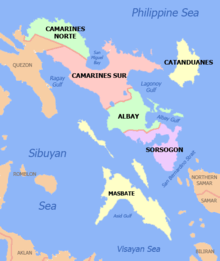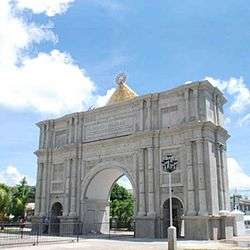Camaligan, Camarines Sur
Camaligan, officially the Municipality of Camaligan (Central Bicolano: Banwaan kan Camaligan; Tagalog: Bayan ng Camaligan), is a 5th class municipality in the province of Camarines Sur, Philippines. According to the 2015 census, it has a population of 24,109 people.[4]
Camaligan | |
|---|---|
| Municipality of Camaligan | |
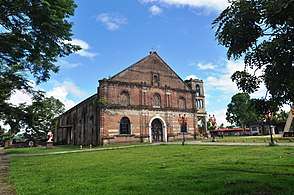 | |
| Etymology: Tagalog: kamalig + an ("place of sheds") | |
| Nickname(s): The Small Town with a Big Heart | |
| Anthem: Camaligan Kong Namomótan My Beloved Camaligan | |
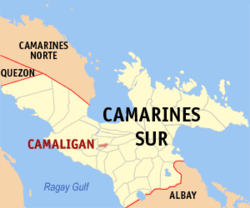 Map of Camarines Sur with Camaligan highlighted | |
OpenStreetMap 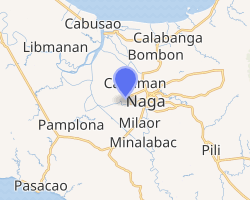
| |
.svg.png) Camaligan Location within the Philippines | |
| Coordinates: 13°37′30″N 123°09′25″E | |
| Country | |
| Region | Bicol Region (Region V) |
| Province | Camarines Sur |
| District | 3rd district |
| Barangays | 13 (see Barangays) |
| Government | |
| • Type | Sangguniang Bayan |
| • Mayor | Marilou Marquez-Hirose |
| • Vice Mayor | Diano S. Ibardaloza, Jr.[2] |
| • Council Members | Members[2]
|
| • Congressman | Gabriel H. Bordado Jr. |
| • Electorate | 15,562 voters (2019) |
| Area | |
| • Total | 4.68 km2 (1.81 sq mi) |
| Population (2015 census)[4] | |
| • Total | 24,109 |
| • Density | 5,200/km2 (13,000/sq mi) |
| • Households | 4,737 |
| Demonym(s) | Camaligueño (masculine) Camaligueña (feminine) |
| Economy | |
| • Income class | 5th municipal income class |
| • Poverty incidence | 24.48% (2015)[5] |
| • Revenue (₱) | 58,700,476.23 (2016) |
| Time zone | UTC+8 (PST) |
| ZIP code | 4401 |
| PSGC | |
| IDD : area code | +63 (0)54 |
| Climate type | tropical rainforest climate |
| Native languages | Central Bikol Tagalog |
| Feast date | June 13 (Poblacion) |
| Catholic diocese | Archdiocese of Caceres |
| Patron saint | St. Anthony of Padua, St. Teresa of Calcutta |
The town is home to the oldest known pre-colonial site in the Bicol region, dating 500 AD to 600 AD, making it an undeclared important archaeological zone.[6]
Etymology
The origin of the town and its name can be traced back to the early settlers of the place. Known as the cortadores, or woodcutters, to the early Spanish colonizers who came to the place in the early 1700s, the settlers cut timbers from nearby mountains located upriver or around San Miguel Bay and made this as their form of living. Out of these timbers, they hewed out canoes or bancas which they stored under small sheds or huts. Later, when these sheds became abundant in the area, as they were made the permanent dwelling places by these canoe makers, the place was called "Camaligan", which means "a place where many sheds can be found", by combining the root word kamalig (or shed) and the locative suffix -an. The sheds served to shelter the canoe makers and protect their boats from the natural elements. Hence, the name and origin of the town is historically tied to the Bicol River and its early inhabitants.[7]
"Catagbacan" was the oldest known name of Camaligan. Moreover, according to D. Adolfo Puya y Ruiz, in his “Camarines Sur – Descripcion General De Està Provincia En Luzon” (Manila: 1887), Camaligan was called "Kinamaligan" before.[7]
Geography
With an area of 468.8 hectares (1,158 acres), it is the smallest municipality in Camarines Sur, but it is the densest, having an approximation of 5,200 persons per square kilometer,[8] which is almost twice the density of the neighboring City of Naga of 2,456 per square kilometer.[9]
Barangays
Camaligan is politically subdivided into 13 barangays.[10]
| Barangays | Class | Population[11] | Barangay Head |
|---|---|---|---|
| Dugcal | Rural | 4,464 | Gabriel Jr. DV. Flores |
| Marupit | Rural | 4,510 | Delia B. Mansor |
| San Francisco | Rural | 745 | Eden G. Torallo |
| San Jose-San Pablo (Poblacion) | Rural | 671 | Eden B. Bon |
| San Juan-San Ramon (Poblacion) | Rural | 982 | Emeterio M. Avila |
| San Lucas (Poblacion) | Rural | 578 | Cyril O. Agomaa |
| San Marcos (Poblacion) | Rural | 1,388 | Danilo I. Villamor |
| San Mateo (Poblacion) | Rural | 1,508 | Carlos Q. Mariscal, Jr. |
| San Roque | Rural | 3,585 | Rolando P. Marasigan |
| Santo Domingo (Poblacion) | Rural | 618 | Maria Teresa A. Ruiz |
| Santo Tomas (Poblacion) | Rural | 810 | Maria Jasmin M. Trinidad |
| Sua | Rural | 2,154 | Servando Santa Ana |
| Tarosanan | Rural | 2,096 | Loretta A. Acabado |
Climate
Camaligan has a significant amount of rainfall during the year. This is true even for the driest month. According to the Köppen climate classification system, Camaligan has a tropical rainforest climate or Af. The average annual temperature is 27.1 °C in Camaligan. About 2527 mm of precipitation falls annually.[12]
| Climate data for Camaligan, Camarines Sur | |||||||||||||
|---|---|---|---|---|---|---|---|---|---|---|---|---|---|
| Month | Jan | Feb | Mar | Apr | May | Jun | Jul | Aug | Sep | Oct | Nov | Dec | Year |
| Average high °C (°F) | 32 (90) |
31 (88) |
34 (93) |
36 (97) |
37 (99) |
37 (99) |
36 (97) |
34 (93) |
35 (95) |
34 (93) |
33 (91) |
32 (90) |
34 (94) |
| Average low °C (°F) | 27 (81) |
27 (81) |
29 (84) |
31 (88) |
32 (90) |
32 (90) |
31 (88) |
30 (86) |
30 (86) |
29 (84) |
28 (82) |
28 (82) |
30 (85) |
| Average precipitation mm (inches) | 39.34 (1.55) |
68.7 (2.70) |
26.73 (1.05) |
66.19 (2.61) |
84.49 (3.33) |
178.89 (7.04) |
244.27 (9.62) |
188.3 (7.41) |
160.98 (6.34) |
445.0 (17.52) |
135.5 (5.33) |
367.8 (14.48) |
2,006.19 (78.98) |
| Average rainy days | 16 | 18 | 13 | 15 | 23 | 28 | 30 | 24 | 26 | 27 | 25 | 29 | 274 |
| Source: World Weather Online (Use with caution: this is modeled/calculated data, not measured locally.)[13] | |||||||||||||
History
Pre-colonial era
The town of Camaligan is a known archeological site. In 2016 to 2017, hundreds of artifacts, including shells, jar fragments, tools, other deposits, pig bones, deer bones, stingray cartilage, shark cartilage, and at least fifteen (15) pre-colonial human remains, were found in the area, which marked a revolutionary phase in Bicol archaeology. The shells and tools found in the town was dated back 1,500 years ago or approximately 500 to 600 AD. The site contained no trace of Chinese, Southeast Asian, or South Asian trade links, making Camaligan a pure pre-colonial Bicolano site.[6] [14]
Spanish era
The settlers of the religious visita of Nueva Caceres, which was then under its ecclesiastical jurisdiction, arrived in the town by the 17th century.[7] The pre-colonial cemetery and community center were transformed by the Spanish into the town's current church compound to diminish native belief systems and instill catholicism.[15] During this time, Camaligan had five barrios in its jurisdiction, namely Marupit, Doncal (now Dugcal), Sua, San Roque and Tarosanan. Each barrio has a small wooden chapel.[7]
On 5 June 1795, a petition to the Spanish religious authorities was sent by the natives and signed by the supposedly officials of the place, to request for a resident curate. The officials’ names were Andre Casa, Diego, Lobao, Simeon de la Cruz, Manuel del Espiritu Santo, Fernando Valenzuela, Agustin del Espiritu Santo, Marcos David, Domingo Flores, Pedro Negre, Bartolome Rodriguez and Valentine de los Santos. Fray Rafael de Benavente was appointed as the first parish priest.[7]
American era
In 1902, the municipality was officially established through an act of the Philippine legislature. It also named Pedro Bustamante as the first municipal mayor. This event of the creation of the Municipality of Camaligan was brought about by a historical fact when the town was eventually separated from being as an annex of Nueva Caceres (now Naga City).[7]
Demographics
In the 2015 census, the population of Camaligan was 24,109 people,[4] with a density of 5,200 inhabitants per square kilometre or 13,000 inhabitants per square mile.
|
| ||||||||||||||||||||||||||||||||||||||||||
| Source: Philippine Statistics Authority[4][16][17][18] | |||||||||||||||||||||||||||||||||||||||||||
Economy
Bicol River serves as a natural source of irrigation and fertilization to the town where agriculture is still considered as a major industry.[7]
Out of the 468 hectares total land area, 175 hectares are devoted to rice production, all of which are irrigated and fertilized by the river through its occasional flooding.[7]
Local government
Camaligan is being headed by a mayor who is being elected by its residents.
The current mayor of the town is Marilou Marquez-Hirose.[19] Last May 2019 Election, she has been re-elected for her third and last term as the Municipal Mayor.[2]
Since 1902, thirty (30) mayors already headed the town.
| Term | Mayor[7] |
|---|---|
| 1902-1903 | Pedro Bustamante |
| 1904-1905 | Quintin Bagsic |
| 1905-1906 | Catalino Alayan |
| 1906-1907 | Fabian Garcia |
| 1908-1909 | Tomas Salvador |
| 1909-1911 | Jose Agapor |
| 1912-1915 | Mauricio Cordial |
| 1916-1919 | Liberato Montiveros |
| 1920-1923 | Antonio Santa Ana |
| 1924-1927 | Pedro Flores |
| 1928-1931 | Vidal Custodio |
| 1932-1935 | Elias Agna de Dios |
| 1936-1941 | Teotimo Rebuquiao |
| 1942-1944 | Felipe Cuadrante |
| 1944 | Glecerio Blas |
| 1945 | Andres Diez |
| 1946-1947 | Julio Capucao |
| 1948-1951 | Francisco A. Aurellano |
| 1952-1955 | Buenaventura Plantado |
| 1956-1963 | Agapito T. Loriaga |
| 1964-1967 | Dalmacio Aurellano |
| 1968-1971 | Agapito T. Loriaga |
| 1972-1986 | Dalmacio Aurellano |
| 1986 | Napoleon Valiente |
| 1986-1987 | Amelito Belen |
| 1987 | Fabian A. Valenciano |
| 1987-1988 | Priscilla T. Aurellano |
| 1988-1995 | Manuel N. Prado |
| 1995-2004 | Rolando C. Eduardo |
| 2004-2007 | Pablo N. Prado |
| 2007-2010 | Rolando C. Eduardo |
| 2010-2013 | Emmanuel T. Prado |
| 2013–Present | Marilou Marquez-Hirose |
Culture
The people of Camaligan derived their socio-cultural identity as river people from the existence of the river. Bicol River is an important resource for irrigation and fertilization of the land where agriculture and fishing is still considered as a major industry. The place’s festivals, songs and dances found their roots and inspiration from the river. Hence, the river ecology has bred its own distinct community.[7]
Festivals
Religious and cultural festivals are being held in the town.
- Kamalig Festival - Camaligan's main festival, which happens from June 5 to 13, in celebration of the town's founding anniversary and the feast of St. Anthony of Padua, the town's patron saint.
- Ati-atihan Festival - a street dance competition and parade inspired by the festival in Aklan of the same name, in honor of Santo Niño, the town's second patron.
- Kamaligang Pasko Festival - a celebration of Christmas wherein the town, most especially its people center and its river park, is being decorated, and a man-sized christmas village is being set-up outside the municipal hall.
Tourism
St. Anthony of Padua Parish Church is one of the oldest churches in the province of Camarines Sur.[15] The church is one of the favorite spots for Visita Iglesia in the province.[20]
Santo Domingo Chapel is an old chapel which was a former burial ground during pre-colonial times. It is a central archeological site where a lot of burial jars, porcelains and skeleton bones were found during the diggings.[15]
Sira, or fish, is a small wharf painted with festive colors that is constructed on the riverside of barangay San Francisco. This also serves as a dock for banca passengers.[15]
After the initial launching of Camaligan River Park in 1 June 2014, its tourism industry began to be more active. Its continuous improvements attracted many visitors, mostly coming from the City of Naga, to come and enjoy walking along the riverside.[21]
M/B Camaligan is a motorboat which docks beside Camaligan River Park. Also known as Camaligan River Cruise, it is also a floating restaurant which crosses the Bicol River. Launched last 6 February 2019, it is the newest attraction which promotes the river culture of the town.[21]
 Façade of San Antonio de Padua Parish Church
Façade of San Antonio de Padua Parish Church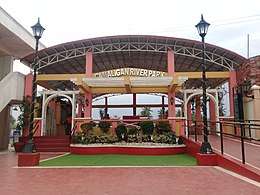 Camaligan River Park's Hall
Camaligan River Park's Hall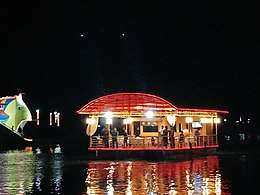 M/B Camaligan passing the Sira
M/B Camaligan passing the Sira
Archaeology
Camaligan is Bicol region's oldest known pre-colonial site, filled with numerous stone tools, jar fragments, shell middens, pig and deer bones, shark and ray cartilages, and other artifacts and biofacts. The site also homes to fifteen human skeletons of pre-colonial Ibalons. The site is so rare and vital as it does not contain any evidences of trade contact with China, Southeast Asian neighbors or South Asia, making it one of the very few pre-colonial sites in the Philippines with distinct Filipino artifacts and biofacts unaffected by outside trade. Both the University of the Philippines and University of California, Los Angeles have been pushing for the town's declaration as an "Important Archaeological Site." Scholars have also been pushing for the site's nomination in the UNESCO World Heritage List.[6][14]
In a documentary made by GMA News TV, it was found that the artifacts and biofacts were not limited to the town proper. In fact, during a road-widening project conducted in September 2017 by the national government, hundreds of human bone fragments, animal bones, burial and ceremonial jar fragments, and stone tools were found after digging only the edges of the road. The documentary also found many Camaligueños to own artifacts they have found in their own land. Due to these findings, the town's reputation as a vital pre-colonial Ibalon archaeological site was solidified.[22]
Educational institutions
Camaligan has one (1) high school, six (6) elementary schools and thirteen (13) preschools. At present, there is no existing tertiary school in the town.
High school
- Camaligan National High School - the only high school in the town. The junior high school campus is located in barangay San Jose-San Pablo, while the senior high school is located in barangay Dugcal.
Elementary schools
- Camaligan Central School - the oldest school and the primary elementary school of the town.
- Sua Elementary School
- Dugcal Elementary School
- San Roque Elementary School
- Marupit Elementary School
- Tarosanan-San Francisco Elementary School
Preschools
- Hansel & Gretel Day Care Center
- Petite L'e' Tudiant Learning Centre
- Dugcal Day Care Center
- Gogon Day Care Center
- Marupit Day Care Center
- San Francisco Day Care Center
- San Juan Day Care Center
- San Lucas Day Care Center
- San Mateo Day Care Center
- San Roque Day Care Center
- Sua Day Care Center
- Tampac Day Care Center
- Tarosanan Day Care Center
Notable people
- Joyce Nocomura - crowned as Miss Philippines Water 2007.[23]
References
- "Municipality". Quezon City, Philippines: Department of the Interior and Local Government. Retrieved 31 May 2013.
- "Halalan 2019 CAMALIGAN, CAMARINES SUR Results". ABS-CBN. 22 May 2019. Retrieved June 16, 2019.
- "Province: Camarines Sur". PSGC Interactive. Quezon City, Philippines: Philippine Statistics Authority. Retrieved 12 November 2016.
- Census of Population (2015). "Region V (Bicol Region)". Total Population by Province, City, Municipality and Barangay. PSA. Retrieved 20 June 2016.
- "PSA releases the 2015 Municipal and City Level Poverty Estimates". Quezon City, Philippines. Retrieved 1 January 2020.
- Escandor, Juan Jr."1500-yr-old artifacts found in CamSur". Inquirer.net. 18 August 2017. Retrieved June 16, 2019.
- Marcaida, Dominador Jr. "Camaligan Town and Municipality History". Academia. 30 September 2016. Retrieved June 16, 2019.
- "Camaligan, Province of Camarines Sur". PhilAtlas. nd. Retrieved June 16, 2019.
- Brinkhoff, Thomas (31 October 2017). "Naga: City in Luzon". City Population. Retrieved 16 June 2019.
- "Camaligan:DILG Region V Camarines Sur". DILG Region V. Retrieved 16 June 2019.
- "Countryside in Figures: Camarines Sur 2018". PSA CamSur. PSA CamSur. 2018. p. 53. Retrieved 12 June 2019.
- "Climate-Data.org". Climate Sahara: Temperature, Climograph, Climate table for Sahara - Climate-Data.org. 9 August 2015. Retrieved 17 February 2019.
- "Camaligan, Camarines Sur: Average Temperatures and Rainfall". World Weather Online. Retrieved 29 October 2017.
- Escandor, Juan Jr."Hispanic burial ground unearthed in Camsur". Lifestyle.inq. 31 July 2017. Retrieved June 16, 2019.
- "Historic Camaligan". I Know Places. 30 March 2019. Retrieved June 16, 2019.
- Census of Population and Housing (2010). "Region V (Bicol Region)". Total Population by Province, City, Municipality and Barangay. NSO. Retrieved 29 June 2016.
- Censuses of Population (1903–2007). "Region V (Bicol Region)". Table 1. Population Enumerated in Various Censuses by Province/Highly Urbanized City: 1903 to 2007. NSO.
- "Province of Camarines Sur". Municipality Population Data. Local Water Utilities Administration Research Division. Retrieved 17 December 2016.
- "2016 Election Results: Councilor, Lone District of Camaligan". Rappler. 19 May 2019. Retrieved June 16, 2019.
- "VISITA IGLESIA IN CAMARINES SUR, PHILIPPINES – 7 CHURCH IN 7 DAYS ITINERARY". Two Monkeys Travel. 2 February 2019. Retrieved 13 June 2019.
- "#NCDTravels: Camaligan Floating Restaurant/River Cruise". Naga City Deck. 26 February 2019. Retrieved 13 June 2019.
- "iJuander: Mga kagamitang nagmula sa sinaunang sibilisasyon, namataan sa Camarines Sur". Youtube. GMA Public Affairs. 21 September 2017. Retrieved 16 June 2019.
- "Miss Philippines Earth 2007 Winners". Mukamo. Mukamo. 6 July 2018. Retrieved 18 February 2019.
External links
| Wikimedia Commons has media related to Camaligan, Camarines Sur. |
